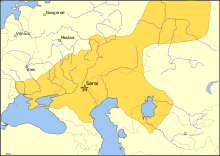Edigu
Edigu (also Edigey, Eðivkäy or Edege Mangit; 1352–1419) was a Mongol emir of the White Horde who founded a new political entity, which came to be known as the Nogai Horde.
Life
[edit]

Edigu was from the Crimean Manghud tribe, the son of Baltychak, a Mongol noble who was defeated and killed by Khan Tokhtamysh of the Golden Horde in 1378. He gained fame as a highly successful general of Tokhtamysh before turning the arms against his master. By 1396, he was a sovereign ruler of a large area stretching between the Volga and Ural (known locally as Yayyk) rivers, which would later be called the Nogai Horde.
In 1397, Edigu allied himself with Timur-Qutlugh and was appointed General and commander-in-chief of the Golden Horde armies. In 1399 he inflicted a crushing defeat on Tokhtamysh and Vytautas of Lithuania at the Battle of the Vorskla River.[1] Thereupon he managed to unite under his rule all Jochi's lands, albeit for the last time in history.
In 1406, he located his old enemy Tokhtamysh in Siberia. Edigu's agents killed Tokhtamysh. The following year he raided Volga Bulgaria. In 1408, he staged a destructive Tatar invasion of Russia due to tribute not being paid in several decades, leading to Vasily I of Moscow to end fighting against Lithuania.[2] Edigu burned Nizhny Novgorod, Rostov, Serpukhov and other towns,[3] and then laid siege to Moscow.[1] Edigu summoned troops from Tver, but the prince made sure his soldiers would arrive too late to be of any use.[1] Instead of taking Moscow, Edigu contented himself with extracting a ransom from its inhabitants before returning to the steppe.[1]
Two years later, Edigu was dethroned in the Golden Horde and had to seek refuge in Khwarezm. Though he had previously had relations with the Timurid ruler Shah Rukh, including marrying his daughter to the latter's son Muhammad Juki,[4] Shah Rukh later had Edigu expelled back to Sarai. However, Edigu managed to ravage Kiev under Lithuanian rule in spring 1416, in which he burnt the Pechersk Monastery and the old town, but was unable to capture its castle.[5] In 1418, he offered Vytautas peace and alliance against Tokhtamysh's sons.
In 1419, he was assassinated by one of Tokhtamysh's sons in Sarai. Edigu's dynasty in the Nogai Horde continued for about two centuries, until his last descendants moved to Moscow, where they took baptism and became known as Princes Urusov and Yusupov.
Assessment
[edit]The Mamluk-era historian Al-Maqrizi describes him as being courageous, generous and someone "who loved Islamic scholars and sought to be close to the pious". He praises him for being a righteous Muslim who fasted and followed the laws of Islam. Al-Maqrizi also says that Edigu prohibited the Tatars from selling their sons and due to this not many of them were bought to the Mamluk territories of Egypt and Syria.[6]
References
[edit]- ^ a b c d Halperin 1987, p. 76.
- ^ Crummey, Robert O. (6 June 2014). The Formation of Muscovy 1300 - 1613. Routledge. p. 66. ISBN 978-1-317-87199-6.
- ^ Shaikhutdinov, Marat (2021). Between East and West: The Formation of the Moscow State. Academic Studies Press. p. 102. doi:10.2307/j.ctv249sgn2. ISBN 978-1-64469-713-9. JSTOR j.ctv249sgn2.
In 1408, Khan Bulat Timer sent Emir Edigu to Russia. The emir informed Vasily Dmitrievich that the khan was going to Lithuania, while he was sent to Moscow. Edigu's troops burned Nizhny Novgorod, Rostov, Dmitrov, and Serpukhov
- ^ Devin DeWeese, Islamization and Native Religion in the Golden Horde (2010), p. 338
- ^ Ivakin G. (1996). "Історичний розвиток Києва XIII – середина XVI ст" [Historical development of Kyiv XIII – middle of XVI century]. litopys.org.ua (in Ukrainian). Archived from the original on 8 July 2017.
- ^ المقريزي, تقي الدين (2002). الجليلي, محمود (ed.). درر العقود الفريدة في تراجم الاعيان المفيدة (in Arabic). دار الغرب الإسلامي. p. 436.
Bibliography
[edit]- . Brockhaus and Efron Encyclopedic Dictionary (in Russian). 1906.
- Halperin, Charles J. (1987). Russia and the Golden Horde: The Mongol Impact on Medieval Russian History. Indiana University. p. 222. ISBN 9781850430575. (e-book).
